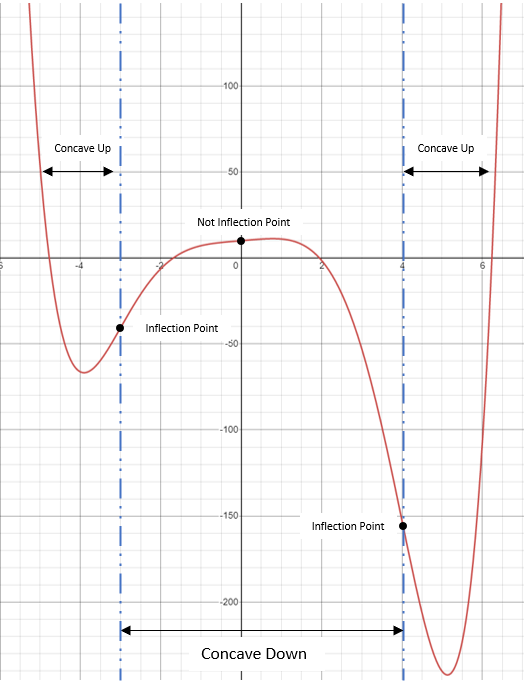Multi Roots
For the curve represented by the equation below, find the point of inflection(s).

Expand Hint
First, find the second derivative of
$$f(x)$$
.
Hint 2
Set
$$f''(x)=0$$
to solve for the inflection point.
An inflection point is a point on the curve/graph at which concavity changes, and occurs when
$$f''(x)=0$$
.
Using the power rule for the first derivative and applying it twice, we’ll get the second derivative power rule:
$$$\frac{d^2}{dx^2}[x^n]=\frac{d}{dx}\frac{d}{dx}[x^n]=\frac{d}{dx}[nx^{n-1}]=n\frac{d}{dx}[x^{n-1}]=n(n-1)(x^{n-2})$$$
Thus, the second derivative is:
$$$f''(x)=\frac{(6)(6-1)}{30}x^{6-2}-\frac{(5)(5-1)}{20}x^{5-2}-(4)(4-1)x^{4-2}+(0)+(0)$$$
$$$=\frac{(6)(5)}{30}x^{4}-\frac{(5)(4)}{20}x^{3}-(4)(3)x^{2}$$$
$$$f''(x)=\frac{30}{30}x^{4}-\frac{20}{20}x^{3}-12x^{2}=x^4-x^3-12x^2$$$
To obtain the x-component inflection point(s), solve for
$$x$$
when
$$f''(x)=0$$
. However,
$$f''(x)$$
is a polynomial, so we have to factor to determine its roots:
$$$x^4-x^3-12x^2=0$$$
$$$x^2(x^2-x-12)=0$$$
$$$x^2(x+3)(x-4)=0$$$
There are three solutions/roots based on the simplified polynomial:
$$x=0,-3,\&\:4$$
. However, all three may not be inflection points since we need to determine if concavity changes between these roots. If we choose an arbitrary sample number between the intervals before and after the root points, we can determine concavity direction by plugging in the sample number into
$$f''(x)$$
and solving accordingly. If
$$f''(x)>0$$
then concavity is up. If
$$f''(x)<0$$
, then concavity is down.

Therefore, the function is concave up from (-∞, -3), then concave down from (-3, 4), and finally concave up again from (4, ∞), meaning there are only two points of inflection (
$$x=-3\: \&\:4$$
).
The inflection point consists of both a
$$x$$
and
$$y$$
coordinate. We have solved and confirmed the
$$x$$
component, but still need to determine the
$$y$$
component. To find
$$y$$
, plug the
$$x$$
component back into the original function:
$$$f(-3)=\frac{(-3)^6}{30}-\frac{(-3)^5}{20}-(-3)^4+2(-3)+10$$$
$$$=24.3-(-12.15)-81+-6+10=-40.6$$$
$$$f(4)=\frac{(4)^6}{30}-\frac{(4)^5}{20}-(4)^4+2(4)+10$$$
$$$=136.53-51.2-256+8+10=-152.7$$$
Thus, the inflection points are at (-3, -40.6) and (4, -152.7). Below is the function graphed for visualization:

(-3, -40.6) and (4, -152.7)
Time Analysis
See how quickly you looked at the hint, solution, and answer. This is important for making sure you will finish the FE Exam in time.- Hint: Not clicked
- Solution: Not clicked
- Answer: Not clicked
Similar Problems from FE Sub Section: The Derivative
342. Inflection Point
353. Inflections
Similar Problems from FE Section: Differential Calculus
040. Integrals
043. A Calc Question
044. Definite Integrals
048. Derivative
051. 2nd Derivatives
077. Area Under a Curve
078. Derivatives
122. Roller Coasters
158. A Train's Velocity
308. Definite Integral
312. The Derivative
342. Inflection Point
353. Inflections
394. Acceleration
408. Triple Integrals
412. Hill Bomb
416. Trip Integral
430. A Curve’s Area
643. Integral Finding
650. Differentiate